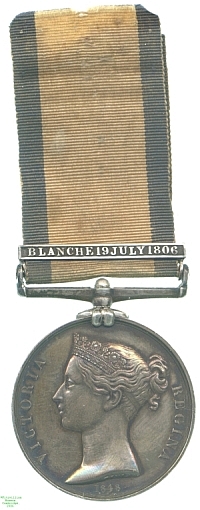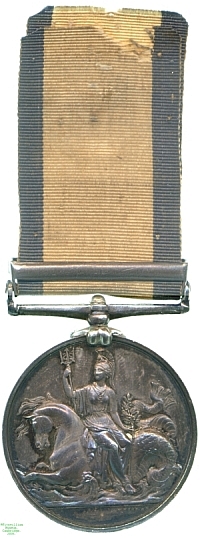
Obverse, a bust of Queen Victoria

Reverse, Britannia with a trident seated sideways on a seahorse

Obverse, a bust of Queen Victoria |

Reverse, Britannia with a trident seated sideways on a seahorse |
Just as in 1848 the extensive land campaigns of the Napoleonic Wars and the other conflicts of the pre-Victorian era were recognised by the issue of the Military General Service Medal, those serving in the Navy at the time were recognised with the Naval General Service Medal. As with the Army equivalent and the East India Company's related award, many of the battles for which the medal was awarded had been fought so long ago that few if any claimants survived.
In addition, bars were awarded for many actions whose significance and size were, despite the heroism displayed by those involved, relatively minor. The result was that many of the bars were issued in tiny numbers, with some combinations all but unique, and the medals command a very high price among collectors because of this rarity and individuality. This in turn, along with the manufacture in most cases of more bars than were eventually issued, has led to the `improvement' of many common awards where recipients' names are shared with those present at `rarer' battles. The medal also shares with the Military General Service and Army of India Medals the oddity that Queen Victoria, whose portrait they bear, was not the ruler under whom the battles for which it was awarded were fought.
One of the smaller engagements for which the medal was awarded (22 bars only) was an encounter off the Faroe Islands between the 46-gun frigate HMS Blanche and the French fifth-rate HMS Guerrière, which had been harassing Greenland fishing vessels. Sources differ as to whether Blanche was outgunned by the French warship or not, but in any case Captain Lavie of the Blanche succeeded in capturing Guerrière, which was taken under the British flag only to be lost to the guns of USS Constitution in 1812. Lavie was knighted for the action; 42 years later the survivors of his crew also received some recognition.
This medal was awarded to John Cowen. The Medals Roll confirms the award of this piece to him, although it gives his name as Cohen. Lester Watson purchased the medal from the London dealers Baldwin in 1928. It had previously been part of the Murray Collection.